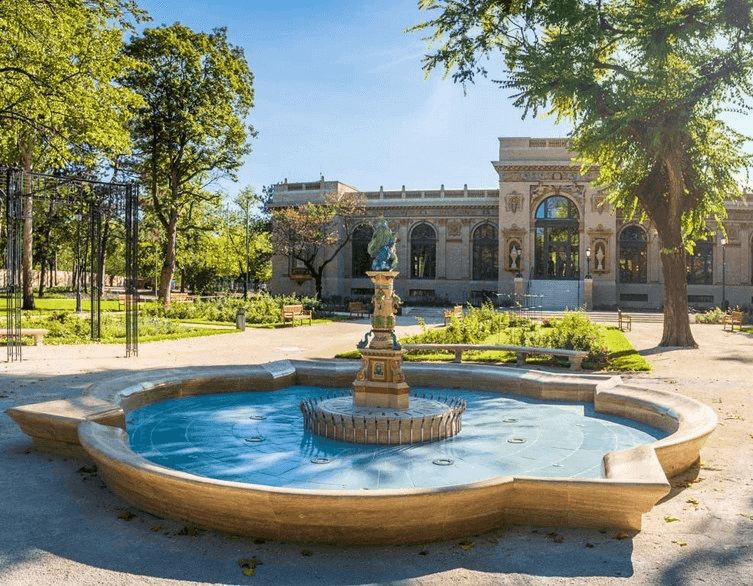Budapest’s Living Porcelain Heritage: A Journey Through Art, Craftsmanship, and Cultural Legacy

Budapest stands as a testament to Hungarian porcelain artistry, where centuries-old craftsmanship comes alive through stunning public installations and private collections. For foreign tourists seeking an authentic cultural experience, three magnificent locations showcase the pinnacle of Hungarian porcelain heritage: the complementary Zsolnay and Herend fountains at József Nádor Square, the elegant Zsolnay fountain at the Millennium House Rose Garden, and the incomparable private Zsolnay collection housed within the architectural masterpiece that is ResoArt Villa.
These sites offer more than mere sightseeing—they provide an immersive journey through the evolution of Hungarian ceramic arts, from the industrial innovations of the 19th century to the refined luxury goods that continue to grace royal courts worldwide today.
József Nádor Square: Where Two Porcelain Empires Meet
The Zsolnay Fountain – A Neo-Renaissance Marvel
Standing proudly in the southern section of József Nádor Square, the Zsolnay fountain represents one of Budapest’s most impressive demonstrations of Hungarian ceramic craftsmanship. This neo-Renaissance masterpiece is actually a faithful replica of the original 1880s “Hercules Fountain” (also known as the Băile Herculane Well), originally designed by renowned architect Ignác Alpár. The contemporary version, completed in 2019, showcases the enduring appeal and technical mastery of Zsolnay ceramics.
The fountain’s construction demonstrates the innovative pirogránit technology that became synonymous with Zsolnay’s reputation. This specially developed ceramic material is frost-resistant, waterproof, and exceptionally durable against weather conditions, making it ideal for outdoor installations. The fountain’s impressive dimensions—standing 4.25 meters tall with a basin diameter of 3.20 meters—create a commanding presence in the square.
The fountain’s design features intricate water spouts shaped like fish, while the lower section showcases detailed relief sculptures of water birds. Water cascades gracefully from the ornate porcelain upper section through these decorative spouts into the middle basins, then flows into the larger collection basin below. During evening hours, illuminated motifs at the basin’s base create a magical ambiance, highlighting the fountain’s artistic details.
The fountain consists of 56 individual ceramic elements, each carefully crafted using traditional Zsolnay techniques. This level of detail reflects the manufactory’s commitment to both artistic excellence and technical precision, qualities that have made Zsolnay ceramics internationally renowned since the mid-19th century.
The Herend Tree of Life – Illuminated Elegance
The northern section of József Nádor Square features an equally spectacular creation: the Herend Porcelain Manufactory’s “Tree of Life” fountain. This 2.80-meter-tall masterpiece stands in a water-surrounded basin, where foam nozzles create playful water movement and add unique visual appeal to the artwork.
The Tree of Life fountain showcases the famous Rothschild pattern, one of Herend’s most iconic designs featuring birds that symbolize togetherness—one of humanity’s oldest symbols of unity. The pattern’s intricate hand-painted details demonstrate the exceptional skill of Herend artisans, who continue to use traditional techniques passed down through generations.
What makes this fountain particularly enchanting is its internal illumination system, which lights up the ceramic fruits from within. This innovative feature transforms the fountain into a glowing beacon during evening hours, creating a mystical atmosphere that attracts both locals and tourists throughout the day and night.
The fountain represents Herend’s commitment to combining traditional craftsmanship with contemporary innovation. Each decorative element is hand-painted using the same meticulous techniques that have made Herend porcelain a favorite among royal households worldwide, including the British Royal Family.
The Zsolnay Garden Fountain – Architecture and Ceramics in Harmony
Located in the heart of City Park, the Millennium House (Olof Palme House) features a romantic Rose Garden centered around an exquisite Zsolnay fountain. This fountain creates a perfect synthesis between the building’s architectural elements and landscape design, showcasing how Zsolnay ceramics were integrated into Budapest’s urban fabric during the Art Nouveau period.
The Rose Garden fountain was created using original drawings from Zsolnay’s pattern books, combining multiple design elements from the house’s construction period with decorative motifs that appear on the building’s facade. This careful attention to historical authenticity ensures that visitors experience the complete artistic vision of the era.
The fountain’s glazing, coloring, and surface treatments mirror those found on the original ceramic elements of the Millennium House facade, creating a seamless visual connection between architecture and landscape. This integration demonstrates how Zsolnay ceramics were not merely decorative additions but integral components of comprehensive artistic designs.
The Building’s Zsolnay Heritage
The Millennium House itself stands as one of City Park’s oldest and most ornately decorated buildings, originally constructed for the 1885 National General Exhibition. Designed by Ferenc Pfaff, the building gained particular recognition for its exceptional Zsolnay decorations, which were specifically noted for their vibrant colors and artistic quality.
The building’s unique Zsolnay decorative elements survived World War II damage and subsequent renovations, maintaining their original artistic integrity. The 2019 renovation carefully restored these ceramic treasures, ensuring that visitors can appreciate both the historical significance and artistic beauty of late 19th-century Hungarian ceramics.
The Rose Garden surrounding the fountain creates a century-old atmosphere that transports visitors back to the golden age of Budapest’s cultural development. This historically-informed landscape design provides the perfect setting for contemplating the artistic achievements of Hungarian ceramic artists and the role of decorative arts in creating urban environments.
Best deals of Budapest
ResoArt Villa: Budapest’s Greatest Private Zsolnay Collection
The ResoArt Villa stands as one of Budapest’s most outstanding examples of Art Nouveau architecture, designed by Albert Kőrössy in 1899 and representing a unique blend of Hungarian Secessionist style with French Art Nouveau and German Jugendstil influences. However, the building’s architectural significance is matched by its role as home to Budapest’s largest private Zsolnay collection, making it an essential destination for understanding Hungarian ceramic heritage.
The villa’s facade features rich ornamentation including floral motifs, fruits, animal figures including lions and peacocks, plus mythological creatures like gorgons and nymphs. This decorative program creates the perfect setting for the extraordinary ceramic collection housed within.
The Collector’s Vision – Szabó András and His Legacy
The ResoArt Villa’s Zsolnay collection belongs to András Szabó, a dedicated collector who transformed his private passion into a public cultural resource. The collection consists of approximately 1,000 pieces, primarily focusing on decorative ceramics created during Zsolnay’s golden age from the 1870s to the 1920s.
The collection’s core represents the historicist style period from the mid-1870s to the turn of the century, with particular emphasis on the years 1878-1885, considered Zsolnay’s first golden age both technically and artistically. This focused approach allows visitors to understand the evolution of Zsolnay’s artistic and technical innovations during their most productive period.
The Guided Experience – “The Collector’s House”
The villa’s “Collector’s House” guided tours last approximately 1.5 to 2 hours, providing an intimate and comprehensive exploration of both the building’s history and the Zsolnay collection. These tours go beyond simple object viewing to explore the collector’s personal motivations, his approach to value preservation, and his decision-making process regarding acquisitions and conservation.
Visitors learn about the sources of objects, discover the collector’s favorite pieces, and understand why nothing from the collection has ever been sold. This personal approach creates a unique museum experience that combines scholarly knowledge with the passion of private collecting.
The tours also include appreciation of Róth Miksa’s breathtaking stained glass windows, which remain largely in original condition despite the vicissitudes of the past century. These windows, created by Hungary’s greatest Art Nouveau stained glass master, provide additional context for understanding the villa’s artistic significance.
The Art of Hungarian Porcelain Craftsmanship
Zsolnay Innovations – Technical Mastery and Artistic Vision
Zsolnay Porcelain Manufactory, founded in Pécs in 1853 by Miklós Zsolnay, revolutionized ceramic arts through groundbreaking technical innovations and artistic excellence. Under the leadership of Vilmos Zsolnay from 1863, the company achieved international recognition and developed technologies that remain influential today.
The introduction of eosin glaze in 1893 represented one of Zsolnay’s most significant contributions to ceramic arts. This innovative glazing technique created a reddish, iridescent finish that changed appearance depending on viewing angle, producing distinctive metallic shimmer. The eosin glaze became synonymous with Art Nouveau decorative arts and established Zsolnay as a leading supplier to the international artistic community.
Pirogránit, developed from 1886, represented another major Zsolnay innovation. This high-temperature fired ceramic proved frost-resistant and chemical-resistant, making it ideal for architectural applications. Renowned architects including Ybl Miklós, Ödön Lechner, Samu Pecz, and Imre Steindl incorporated pirogránit into iconic buildings throughout Budapest and Hungary.
The artistic program behind Zsolnay’s success involved multiple family members and collaborators. Julia Zsolnay, Vilmos’s daughter, created extravagant Japanese-Turkish-Persian influenced patterns and family emblems that became signature Zsolnay designs. Teréz Zsolnay drew inspiration from Hungarian folk art motifs, building a collection of more than 10,000 ethnographic objects that informed her designs.
Herend Excellence – Royal Patronage and Artistic Refinement
Herend Porcelain Manufactory, founded in 1826 by Vince Stingl and later developed by Mór Fischer from 1839, became Hungary’s most internationally recognized luxury brand. The company’s success stemmed from Fischer’s commitment to exclusively producing artistic, hand-painted porcelain that met international standards.
Herend’s breakthrough came at the 1851 Great Exhibition in London, where Queen Victoria commissioned a china set featuring the butterfly and floral pattern that became known as the “Victoria pattern”. This royal endorsement established Herend’s international reputation and led to orders from multiple European royal courts.
The company’s recognition reached its peak in 1872 when Emperor Franz Joseph awarded Herend the title of Supplier to the Imperial and Royal Court. This prestigious designation confirmed Herend’s status as a producer of luxury goods suitable for the highest levels of European society.
Herend’s fish scale pattern, developed in 1858 when an artist applied the design to a rooster figurine to simulate feathers, became another iconic element of the company’s artistic identity. Originally painted in black, this pattern gained renewed popularity in blue during the 20th century and continues to appear on countless animal figurines.
The manufactory’s production capabilities are staggering: over its nearly 200-year history, more than 16,000 shapes and 4,000 samples have been created, theoretically allowing for 64 million different porcelain products. This vast repertoire demonstrates the company’s commitment to continuous innovation while maintaining traditional craftsmanship standards.
Hollóházi Legacy – Hungary’s Oldest Ceramic Tradition
Hollóházi Porcelain Manufactory holds the distinguished honor of being Hungary’s oldest continuously operating porcelain factory, with production beginning in 1777 on the Károlyi family estate in Hollóháza. Originally established as a glass workshop, the facility transitioned to ceramics production in 1831 when competition from Czech, German, and Italian glassmakers made the original business model unsustainable.
The manufactory’s strategic location provided exceptional natural advantages for ceramic production, with local kaolin deposits and abundant water sources ensuring superior raw material quality from the outset. This geographical blessing allowed Hollóházi artisans to develop distinctive production techniques that took full advantage of regional resources.
Ferenc Istványi’s leadership (1860-1902) transformed Hollóházi from a small local operation into a sophisticated manufacturing enterprise capable of international competition. His innovations included establishing a proper laboratory for glaze development, introducing gold decoration techniques, and creating the vibrant floral motifs that became synonymous with Hollóházi porcelain. Most significantly, Istványi developed the distinctive pine tree motif that serves as Hollóházi’s trademark to this day.
Under Istványi’s guidance, the factory achieved international recognition at the 1896 Millennium Exhibition in Budapest and the 1900 Paris World’s Fair, establishing Hungary’s ceramic reputation on the global stage. The company successfully exported to Bulgaria, Germany, and Serbia, proving that Hungarian craftsmanship could compete in demanding international markets.
The technical quality of Hollóházi porcelain stemmed from its unique production methods, which emphasized the natural properties of local kaolin while incorporating artistic influences from various European ceramic traditions. The factory’s artisans developed specialized techniques for creating the distinctive red-white-green glazes that became characteristic of Hungarian ceramic arts.
Following World War I, ownership changes and economic difficulties led to temporary quality decline, but Károly Szakmáry’s acquisition of the factory in 1939 initiated ambitious modernization efforts. Szakmáry installed new equipment, electrified production, and added three modern electric kilns, enabling the creation of new products and patterns that appealed to contemporary urban audiences while maintaining traditional craftsmanship standards.
The 1948 nationalization initially restricted production to industrial porcelain only, temporarily halting decorative and household porcelain manufacturing. However, artistic production resumed in 1957 with the involvement of talented young artists like Endre Szász, who brought fresh perspectives to traditional Hollóházi design philosophy.
Contemporary Hollóházi production maintains nearly 250 years of continuous operation while representing both traditional craftsmanship and modern artistic directions. The factory continues to produce classic patterns alongside contemporary design series, demonstrating how traditional techniques can adapt to evolving aesthetic preferences without losing their essential character.
What makes Hollóházi porcelain particularly special is its role as a living cultural monument—the oldest Hungarian porcelain manufacturer that has maintained continuous production through multiple historical upheavals. While perhaps less internationally famous than Herend or Zsolnay, Hollóházi carries forward the deepest ceramic traditions in Hungarian culture, serving as a bridge between historical craftsmanship and contemporary artistic expression.
The manufactory’s products frequently serve as diplomatic gifts representing Hungarian cultural heritage abroad, contributing to the country’s cultural diplomacy efforts alongside its more widely recognized porcelain siblings. This diplomatic role demonstrates how traditional crafts continue to serve important cultural and political functions in the modern world.
Hollóházi’s workshop remains accessible to visitors as both a production facility and cultural attraction, allowing tourists to observe traditional techniques in their original historical context. This combination of active production and cultural tourism ensures that Hollóházi porcelain traditions remain vibrant and relevant to new generations of admirers while maintaining the authentic character that has sustained the manufactory for nearly two and a half centuries.
Traditional Techniques and Modern Production
Both Herend and Zsolnay maintain traditional hand-crafting techniques that have been passed down through generations of artisans. At Herend, porcelain is made from hard-paste materials including kaolin, feldspar, and quartz, with each piece individually shaped, fired, painted, and gilded by hand.
Herend’s Porcelanium visitor center offers demonstrations of these traditional techniques, allowing visitors to observe pot-throwing, professional painting, and the complete transformation process from raw paste to finished porcelain. These demonstrations reveal the “magicians’ tricks” behind creating some of the world’s most sought-after luxury ceramics.
The Herend Porcelain Museum, established in 1964, received Hungary’s Museum of the Year award in 2002. The museum showcases the complete history of porcelain-making technology and features live demonstrations that guide visitors through every stage of production from forming to painting.
Hungarian Porcelain Heritage: Cultural Legacy and Global Impact
Hungarian porcelain manufacturing represents more than industrial achievement—it embodies national cultural identity and artistic excellence that has gained international recognition for over 150 years. The three major Hungarian porcelain manufacturers—Herend, Zsolnay, and Hollóháza—each contributed unique innovations and artistic approaches that collectively established Hungary as a center of ceramic arts excellence.
Hollóháza Porcelain Manufactory, founded in 1777, holds the distinction of being Hungary’s oldest continuously operating porcelain factory. Originally established as a glass workshop on the Károlyi family estate, the factory transitioned to ceramics production in 1831, utilizing local kaolin deposits and water sources that ensured exceptional product quality from its earliest days.
The manufactory’s golden age under Ferenc Istványi (1860-1902) established Hollóháza as a significant force in Hungarian ceramic arts. Istványi’s innovations included establishing a laboratory, introducing gold decoration, developing vibrant floral motifs, and creating the distinctive pine tree motif that became Hollóháza’s trademark. Under his leadership, the factory exported to Bulgaria, Germany, and Serbia, gaining international recognition at the 1896 Millennium Exhibition and 1900 Paris World’s Fair.
International Recognition and Diplomatic Significance
Hungarian porcelain serves as an important element of the country’s cultural diplomacy, frequently appearing as official state gifts to foreign dignitaries and royal families. Herend porcelain has been presented to notable figures including Pope Benedict XVI, Hillary Clinton, and Queen Elizabeth II, demonstrating its recognition as a symbol of Hungarian excellence.
The British Royal Family’s connection to Herend exemplifies this diplomatic role: Hungary presented Herend tableware as an official wedding gift to Prince William and Princess Catherine, and commemorated the births of Prince George and Princess Charlotte with special pieces. The Royal Garden pattern, a modified version of the Victoria design, allows the Windsor family to set their table at Kensington Palace with Hungarian porcelain, creating a tangible link between Hungarian craftsmanship and British royalty.
Herend currently exports to more than 60 countries worldwide, with primary markets including Italy, Germany, Russia, Japan, and the United States. This global reach demonstrates the universal appeal of Hungarian porcelain craftsmanship and its continued relevance in international luxury markets.
Preservation and Continuity
All three major Hungarian porcelain manufacturers have survived significant historical challenges including world wars, economic crises, and political changes, demonstrating remarkable institutional resilience. The nationalization period under communist rule (1948-1989) paradoxically helped preserve these companies by providing stable funding and maintaining production capabilities during economically difficult periods.
The post-1989 privatization process allowed these companies to modernize while maintaining traditional production methods. Herend became 75% owned by its management and workers in 1992, ensuring that traditional skills and company culture remained intact. This ownership structure creates strong incentives for maintaining quality standards and preserving traditional techniques.
Contemporary production at these manufactories continues to emphasize hand-craftsmanship and traditional techniques, ensuring that skills developed over centuries remain alive and relevant. Modern innovations focus on design and decoration while preserving the fundamental production methods that create each company’s distinctive character.
Educational and Cultural Value
These porcelain institutions serve important educational functions through their museums, visitor centers, and guided tours. The Herend Porcelain Museum offers comprehensive exhibitions on porcelain history and technology, while live demonstrations allow visitors to observe traditional craftsmanship techniques firsthand.
The ResoArt Villa’s approach combines private collecting passion with public education, offering visitors insights into both the technical aspects of Zsolnay production and the personal motivations behind building a significant ceramic collection. This model demonstrates how private initiative can complement institutional preservation efforts.
The Zsolnay Museum in Pécs provides additional context for understanding ceramic development within broader cultural and technological frameworks. These educational resources ensure that appreciation for Hungarian porcelain heritage continues to develop among new generations of both domestic and international audiences.
Planning Your Porcelain Heritage Journey
József Nádor Square is easily accessible in Budapest’s city center, located in District V and reachable via multiple public transportation options. The square operates as a public space with 24-hour access, allowing visitors to appreciate the fountains at different times of day and lighting conditions. Early morning or late afternoon visits provide the best lighting for photography, while evening visits reveal the illuminated features of both fountains.
The ResoArt Villa operates by appointment only, with guided tours available in multiple languages. Tours typically last 1.5 to 2 hours and provide comprehensive exploration of both the building’s architectural significance and the Zsolnay collection. Advance booking is essential, as the villa maintains limited group sizes to ensure intimate, high-quality experiences.
The Millennium House Rose Garden is accessible during City Park’s operating hours, providing a peaceful setting for appreciating the Zsolnay fountain within its landscaped context. The location combines well with other City Park attractions, allowing visitors to create comprehensive cultural itineraries.
Connecting the Experience
These three locations work together to provide a comprehensive understanding of Hungarian porcelain heritage, from the technical innovations and artistic achievements represented in museum collections to the contemporary urban integration demonstrated by the public fountains. Visitors can trace the evolution from 19th-century industrial innovation through Art Nouveau artistic integration to contemporary cultural celebration.
The experience reveals how Hungarian porcelain craftsmanship transcended mere commercial production to become an integral element of national cultural identity, international diplomacy, and urban aesthetic development. These sites demonstrate that Hungarian porcelain heritage remains vibrantly alive, continuing to inspire and delight new generations of admirers while maintaining the traditional craftsmanship techniques that created their original appeal.
Through visiting these locations, foreign tourists gain appreciation not only for the technical excellence and artistic beauty of Hungarian porcelain but also for its role in creating cultural connections that span continents and centuries—a living testament to the enduring power of human creativity and craftsmanship.
Related news
Related events





















